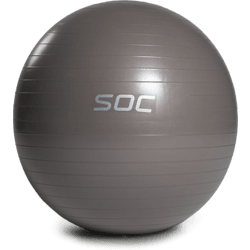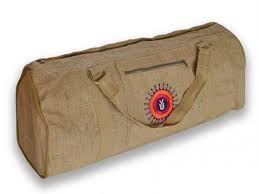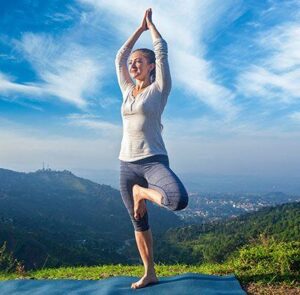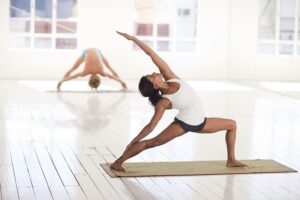Yoga kits are collections of essential items and tools that help enhance your yoga practice. These kits typically include a combination of yoga accessories and props that can support and deepen your poses, improve alignment, and provide comfort during your practice. While the contents of yoga kits may vary, here are some common items you can find in them:
 Here are Yoga kits;
Here are Yoga kits;
-
Yoga Mat: A yoga mat is a foundational item in any yoga kit. It provides a non-slip surface for your practice, cushioning for your joints, and helps define your personal space during group classes.
-
Yoga Block: This is a rectangular foam block used to support and modify poses. They are usually placed under hands, feet or seat in other to achieve proper alignment.
-
Yoga Strap: A yoga strap is a long, sturdy band typically made of cotton or nylon. It helps improve flexibility and allows you to extend your reach in poses where your hands may not reach comfortably.
-
Yoga Bolster: This is a firm cushion used for support and relaxation during restorative poses and meditation. It helps create a more comfortable and relaxing experience.
-
Yoga Blanket: It is used for support and warmth during certain poses. Yoga blanket is used also during the final resting pose (relaxation).
-
Yoga Towel: This is typically made of absorbent material which is used to cover yoga mat. Yoga towel provides additional grip to prevent slipping when you sweat during vigorous practice.
-
Yoga Strap Bag or Mat Carrier: This is used to carry and protect yoga mat and other accessories. They often have extra compartments for storing smaller items like keys, phones, or water bottles.
-
Meditation Cushion or Zafu: For those who incorporate meditation into their yoga practice, a meditation cushion or zafu is a supportive cushion that helps maintain a comfortable seated posture during meditation sessions.
-
Yoga Wheels or Yoga Balls: A yoga ball is aid to deepen stretches, improve balance and provide stability during challenging poses.

Yoga kits are convenient as they provide all the essential tools you need for your practice in one package. They are particularly useful for beginners who may be unsure of what props to acquire. However, it’s important to note that while these items can enhance your yoga experience, they are not essential for practicing yoga. With just a yoga mat and comfortable clothing, you can still have a fulfilling yoga practice.


YOGA POSES
These are also known as asanas, they are specific physical postures practiced in yoga. There are countless yoga poses, each with its own unique benefits for the body, mind, and spirit. Here are descriptions of a few common yoga poses across different categories:




-
Standing Poses:
- Mountain Pose (Tadasana): A foundational pose, standing tall with feet together, grounding through the feet, and lengthening the spine.
- Warrior I (Virabhadrasana I): This is a powerful pose. Put one foot forward, knee bent and arms reaching forehead. cultivating strength and stability.
- Tree Pose (Vrksasana): This pose promotes balance and focuse. Balance on one leg, placing the foot on the inner thigh or calf and bring the hands to the heart.
-
Forward Bends:
- Forward Fold (Uttanasana): This is a Standing pose. Stand with hip-width apart, folding forward with a straight back and reaching towards the toes. While maintaining the position try stretching the hamstrings and calming the mind.
- Seated Forward Bend (Paschimottanasana): This pose requires sitting. Seat with legs extended, bending forward from the hips, reaching for the feet or ankles. While in this position elongate the spine, and stretch the back body.
-
Backbends:
- Cobra Pose (Bhujangasana): This pose requires you to lye on your belly. Then pressing the hands into the mat, lifting the chest while keeping the pelvis grounded, opening the heart, and strengthening the back.
- Bridge Pose (Setu Bandhasana): Lying on the back, bending the knees, lifting the hips off the mat while pressing the feet and shoulders down, strengthening the back body, and opening the chest.
-
Twists:
- Seated Spinal Twist (Ardha Matsyendrasana): Sitting with one leg crossed over the other, twisting the torso towards the bent knee while maintaining a tall spine, massaging the abdominal organs, and improving spinal mobility.
- Revolved Triangle Pose (Parivrtta Trikonasana): Standing with legs wide apart, twisting the torso towards one leg, reaching one hand to the floor or a block while extending the other arm towards the sky. This pose aid in detoxifying and energizing the body.
-
Balance Poses:
- Tree Pose (Vrksasana): Balancing one leg, placing the foot on the inner thigh or calf, and bringing the hands to the heart, promoting balance and focus.
- Eagle Pose (Garudasana): Standing with arms and legs crossed, balancing on one leg, wrapping one arm under the other, and entwining the legs, improving concentration and stability.
-
Inversions:
- Downward Facing Dog (Adho Mukha Svanasana): Starting on hands and knees, lifting the hips towards the sky, forming an inverted V-shape, lengthening the spine, and energizing the body.
- Shoulder Stand (Sarvangasana): Lying on the back and lifting the legs overhead, supporting the back with the hands, reversing the blood flow, and calming the nervous system.
Please note that it’s important to practice yoga poses under the guidance of a qualified yoga teacher to ensure proper alignment and safety. Each pose has variations and modifications that can be tailored to individual abilities and needs. Listen to your body and practice mindfulness, honoring your limitations and avoiding any pain or discomfort.


